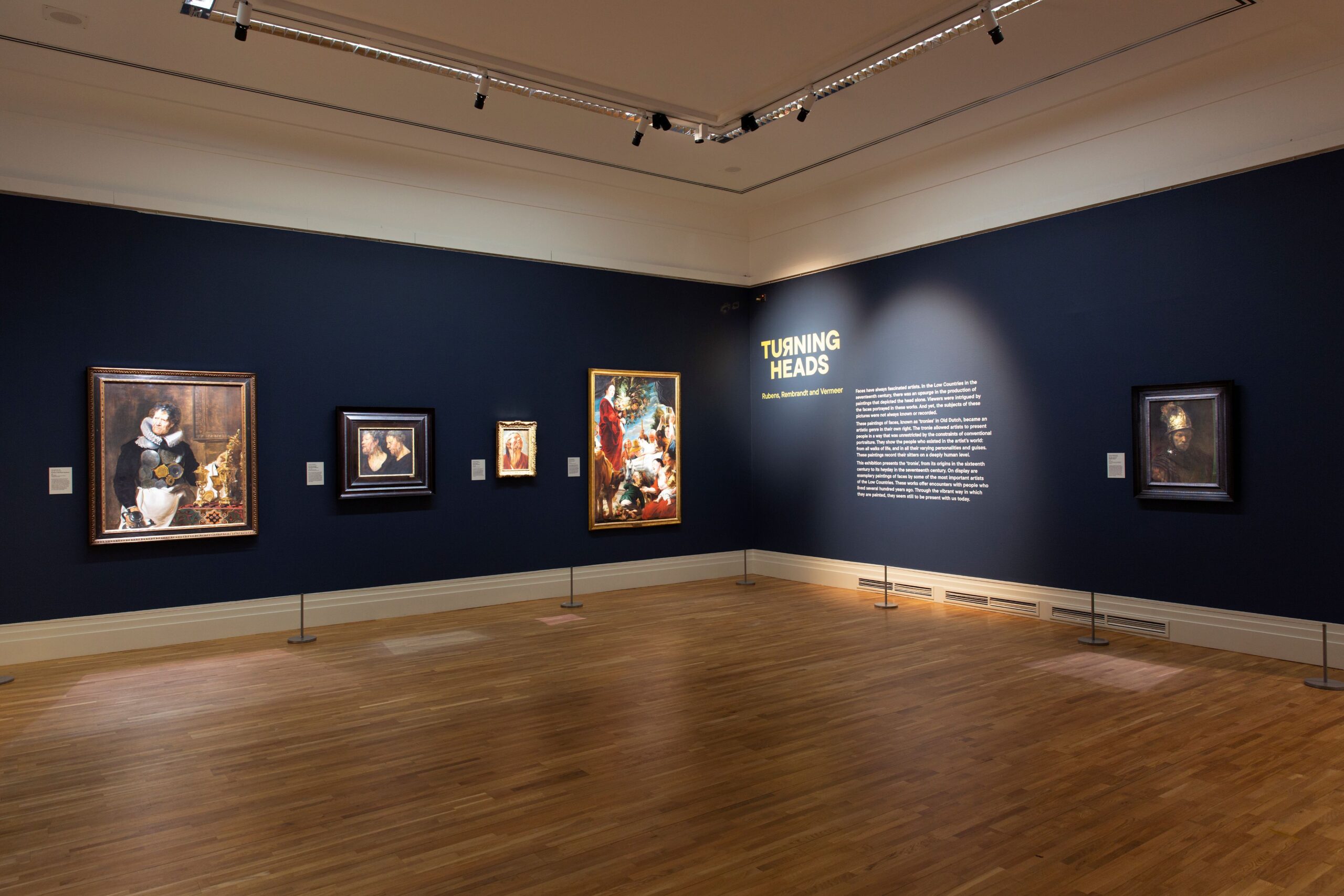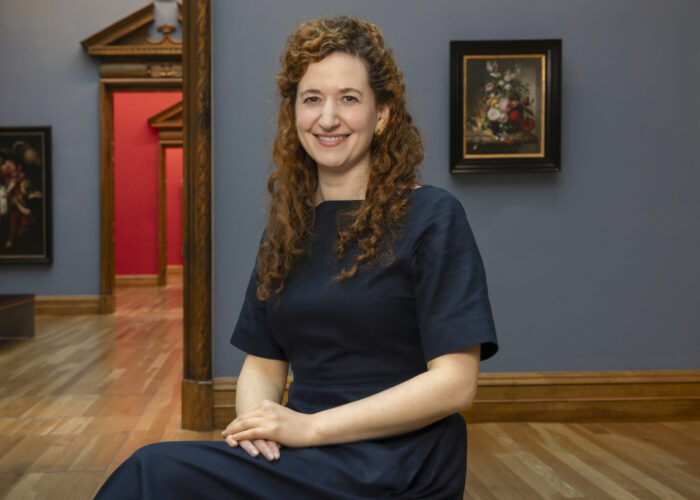Growing up in London, I did not take for granted that art was practically at my doorstep. I recall seeing Dutch paintings at the National Gallery when I was around nine years old and being completely awestruck by the works. I wanted to bring my friends along, to show them how much delight the artworks brought. Now I have come to learn that the role of a curator is fulfilling that same desire. The love for research came in my first year studying History of Art at the University of Cambridge. I chose to write a short dissertation on the Flemish tapestry displayed in King’s College dining hall, which led to a reattribution and a connection to a series of tapestries. It sparked in me an appetite for chasing the sensation that comes with making a discovery.
The red thread in my studies was Dutch and Flemish art. But I have also explored how imagery and ideas from the Low Countries have permeated beyond time and region, for instance, tracing the iconography of broom idioms from Pieter Bruegel the Elder to the present day in African-American wedding customs. I progressed from BA, to MPhil, to PhD with Jean Michel Massing as my supervisor. He kindly feigned retirement to continue working with me on the PhD, and I carry with me his unceasingly open-minded approach to research. Under his supervision, I examined how seventeenth-century Dutch art managed to evoke the paradoxically invisible matter of smell. My PhD thesis, Visualising, Perceiving, and Interpreting Smell in Seventeenth-Century Dutch Art, was completed in 2022. More recently, I have been drawing connections between Dutch art theory with medieval Middle Eastern thought, early Italian Renaissance painting, and the eighteenth-century Paris Salons.
During my doctorate, I was an Andrew W. Mellon Fellow at the Rijksmuseum. My experience there was transformative. Taking the advice of the wonderful Pieter Roelofs, many weekends were spent visiting different collections in the Netherlands. While still in the Netherlands, I also joined the Mauritshuis to work on Fleeting – Scents in Color. The exhibition was an ideal pendant to my PhD research, as it was dedicated to the smells of Dutch art. Working with the brilliant Ariane van Suchtelen, we collaborated with exhibition designers and perfumers to produce devices that could diffuse smells relating to key artworks. It was exciting to see elements of the doctoral research brought to life in the exhibition, which affirmed for me the impact of expressing ideas through objects.
When I moved to Dublin to work as the Curator of Dutch and Flemish Art at the National Gallery of Ireland in 2022, I was introduced to a collection brimming with possibility, and also a wonderful group of colleagues. In early 2023, we displayed St Dymphna: The Tragedy of an Irish Princess, presenting the Phoebus Foundation’s altarpiece by Goossen van der Weyden from ca. 1505, recounting the life and martyrdom of the Irish saint. As a painting series that represents Irish history by a Flemish artist, it was the ideal first project for a curator settling in Ireland. Working for a national collection, it has been important to connect with the public that I serve. I love getting to know our visitors from Ireland through our public programming, and I have been studying the Irish language in my spare time too.

Installation view of Turning Heads: Rubens, Rembrandt and Vermeer, 24 February – 26 May 2024
Photo: National Gallery of Ireland
The 2024 exhibition Turning Heads: Rubens, Rembrandt, and Vermeer, which I co-curated with the Gallery’s Head Curator Brendan Rooney, was a project dedicated to the tronie in Dutch and Flemish art. We partnered with the KMSKA, Antwerp, where we had the pleasure of working with Nico van Hout and Koen Bulckens. We were tasked with introducing a relatively unknown genre to the public, yet the paintings were so evocative that they spoke for themselves. We devised a display of dark exhibition spaces with spot-lit works, giving the impression of coming face-to-face with characters from four centuries ago. Seeing the positive reactions from visitors was eye-opening for me, and suggested a strong appetite for Dutch and Flemish art. It has since shaped my thinking on how our future exhibitions can resonate with our visitors.
In 2024, the Gallery also displayed Vermeer Visits. While the Frick Collection, New York, was under renovation, Vermeer’s Mistress and Maid made an exceptional trip to Dublin, to be displayed alongside the Gallery’s painting by Vermeer, Woman Writing a Letter, with her Maid. We dedicated an entire room for these two spectacular paintings. To promote close looking, we developed upholstered benches for comfortable viewing. The change of atmosphere in the space was palpable. It proved to me that our public’s viewing experience can be transformed under the right conditions.

Rachel Ruysch (1664-1750), Vase of Flowers, with an Ear of Corn, 1742
National Gallery of Ireland, Dublin
As the Gallery is actively acquiring, I am working on how best to expand the national collection through Dutch and Flemish art. A flower still life by Rachel Ruysch was my first acquisition for the Gallery. It is a remarkable piece painted in 1742 when Ruysch was 78 or 79 years old. In 2024–2025 the painting has traveled to the Alte Pinakothek, and Toledo Museum of Art, for her first major monographic exhibition. The painting is a significant acquisition for the Gallery, as it is the first painting by a woman artist to join the Dutch collection.
Another milestone acquisition for the Dutch collection was securing our first print by Rembrandt, representing a landscape of cottages and a hay barn with a fine view of Amsterdam in the distance. We have since also acquired a self-portrait of the artist from ca. 1642. It is vital that our collection comprehensively reflects the history of art, and Rembrandt’s printmaking counts as an important chapter. It brings me a lot of satisfaction to see that they are now being studied by students in the Prints & Drawings Study Room.
Technical research is a key part of how we are gaining new insights into the Gallery’s collection today. We collaborated with our colleagues at the Mauritshuis on a project about Paulus Potter, where technical research on our Head of a White Bull revealed that it is a fragment of a once monumental painting depicting the Abduction of Europa. As we discuss in The Burlington Magazine, the results suggest that Potter took a serious interest in history painting too. Such insights make working with the Conservation Department one of the most rewarding parts of the role. There are other technical research projects I am eager to work on – the hard part is deciding which one to choose next.
The close connections maintained between curators and academics is invaluable. I co-organized with Meredith Hale (University of Exeter) the 2024 Historians of Netherlandish Art Conference in London and Cambridge. We put together a four-day program of 40 paper sessions, and over 30 workshops in collections in London and Cambridge that shed light on the extent and caliber of the holdings of Dutch and Flemish art in just two UK cities. It was exciting to bring together 250 scholars to explore how Dutch and Flemish art is being thought about today, which has since helped in developing my own thinking on curatorial projects. I saw a lot of generosity in the sharing and advocating of one another’s research. The conference highlighted for me how much our field thrives from its collegiality.
It is vital that we ensure that the study and appreciation of Dutch and Flemish art continues for the present and future generations. While serving on the HNA Board, I am a member of the IDEA Sub-Committee, working towards making the field of Dutch and Flemish Art History more inclusive and equitable. I am also Chair of the HNA Mentorship Program. We are about to launch its sixth year running, and to date the program has made more than 200 matches from over a dozen countries. Some of our mentees go on to join CODART and participate in its Mentoring Program. It is hugely gratifying, as we get to follow how participants’ careers flourish during the program, and then over the subsequent years. Having a network of passionate and generous mentors is important to help play a part in making our field prosper.
This is a very exciting time to work as a curator, both within the institution, and internationally. I love that no day is the same, but that it always involves working with spectacular art. Connecting with the CODART network is a highlight, and always something that I look forward to. Perhaps the next opportunity might be in Dublin.
Lizzie Marx is Curator of Dutch and Flemish Art at the National Gallery of Ireland in Dublin. She has been a member of CODART since 2022.



